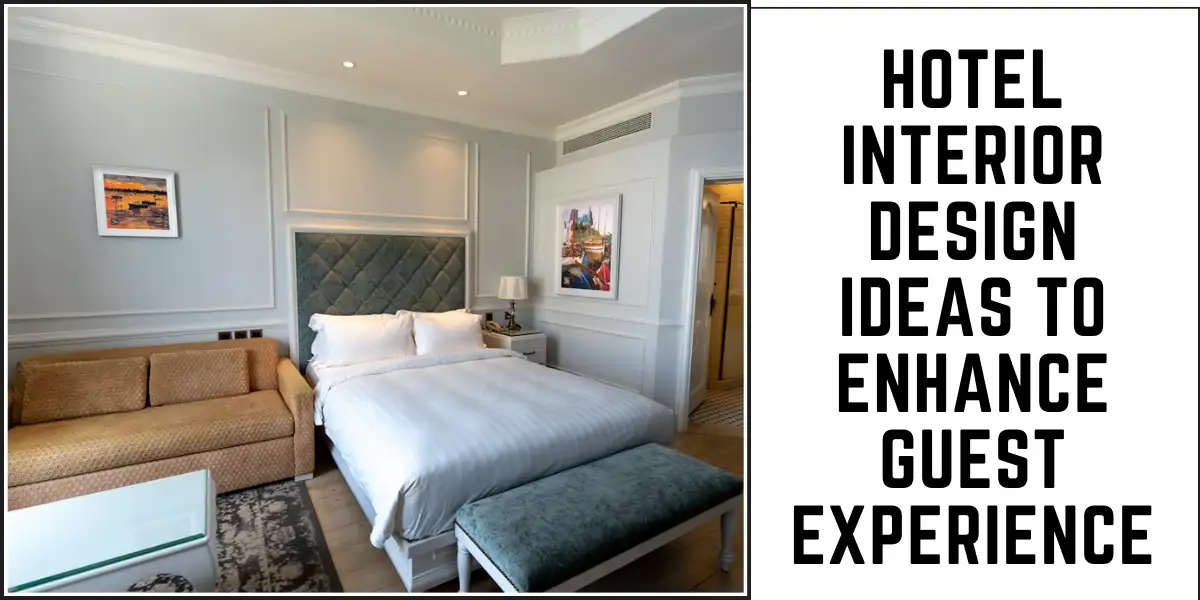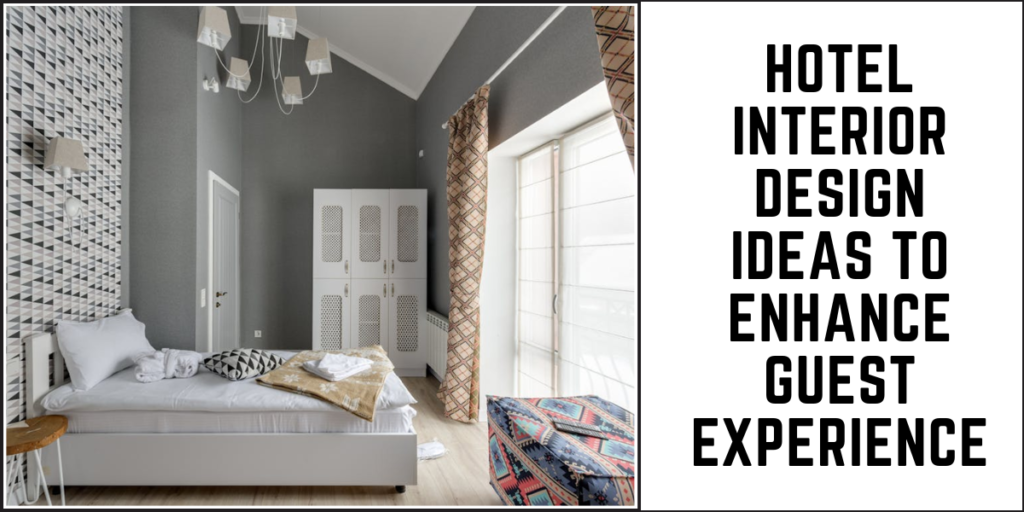Hotel Interior Design Ideas to Enhance Guest Experience

Hotel Interior Design Ideas to Enhance Guest Experience
Hotels have thrived in offering memorable experiences within the hospitality industry. Today, contemporary travelers have become design savvy; hence, good hotels are no longer about comfortable rooms alone or excellent services. A hotel’s ambiance, aesthetics, and sensory appeal all play a vital role in impacting a guest’s total perception.
Interior design, therefore, becomes something even beyond raw decoration-a way of creating emotional and functional responses in guests. From the lobby to the lounge, every bit of space in a hotel is designed for a visitor’s comfort and pleasure, all with a sense of style and character. Here, we have gathered ideas for hotel interiors that can greatly contribute to the guest journey and create valuable memories.
1. Make the Lobby an Influence for First Impressions
The lobby is the very heart of any hotel and the first space a guest enters. It should be visually impressive and importantly warm and welcoming. A lobby nowadays serves not only as the reception counter but also as a waiting area, informal meeting spot, or perhaps new social life. The design should support all of these functions with an effortless flow and interaction.
Important focal points such as lofty ceilings, large-sized chandeliers, and striking works of art can instantly engage a visitor’s interest. These would be further enveloped in natural light and layered textures to give an air of richness and glow to the lobby. Small seating clusters create an intimate charm, while functional zoning for quick check-ins, luggage drop-offs, or social interactions aid in good circulation and convenience.
2. The Design Elements Should Express Local Culture
In an era of global travels, most guests look inwards for some authentic connection with the places they visit. An extremely relevant way to provide that would be through designs inspired by the local culture, history, or art. There are innumerable ways a hotel can express local flavor-from showcasing traditional crafts to the display of artwork by local artists or using indigenous materials embodied in culturally-influenced furniture and decor.
This not only nourishes the local economy, but it also nurtures a very unique identity for the hotel itself. A beach hotel, for example, can have driftwoods and coastal hues as accents; an urban heritage hotel can have vintage photography or regional textiles as its soul. All these culturally rich designs have high emotional resonance with guests and accentuate their travel experience.
3. Guestrooms with Plenty of Thoughtful Details
The guestroom is where most of the time is spent, and it must strike a balance between aesthetics and functionality. Comfort, privacy, a bit of luxury; those are the three adjectives that ought to define an entirely successful guest room. Ensure restful sleep, to begin with, with proper bedding, weighted blackout curtains, and acoustics. The palette for the interiors should impart tranquillity, where neutral colors, weathered pastels, or colors borrowed from nature can best do the job.
Intelligent solutions such as smart lighting controls, USB charging ports, ergonomic furniture, and well-considered mirror placement are always welcome for convenience and comfort. Art pieces, carefully chosen books, and a dedicated welcome note can enhance personality. Finally, large wardrobes, a stylish desk, and sleek bathrooms wrap up the home-away-from-home feel.
4. Designing with the Sensory Experience
A memorable hotel provides experience with all five sensory perceptions. Obviously, the sight is dealt with color, lighting, and decor, but there are many other methods of enhancing sensory experience that guests will remember. Perhaps one of the most subtle yet effective tools available is scent: from a calming or elegant feel created by signature hotel scents in the lobby to hallways and other transitional spaces.
Sound absorption walls with ambient music in public spaces and therapeutic nature sounds in spa areas are another way of diffusing noise while creating a certain mood. The feel of the hotel is also important: think of super-soft carpets, fine bed linens, silky countertops with tactile textiles that exude a sense of quality. You could even incorporate taste into your design with complimentary welcome goodies provided in-room or eye-catching mini-bars. Multisensory design will impart a richer and more immersive experience to every single interaction.
5. A Common Area that is Flexible and Functional
These days, travelers appreciate hotels that offer them flexible spaces where they can work, socialize, or simply take a rest. Designing multi-functional areas in lounges, co-working corners, or rooftop terraces adds serious value to the establishment. Use modular furniture that can be rearranged for singles or group gatherings. Power points, strong wi-fi connection, and atmosphere lighting are also essential in these places.
The design should enable both sociability and seclusion as events demand: a cozy library nook with armchairs, a smart-looking communal table for digital nomads, or a terrace garden with seating for sunset drinks-these together create a communal buzz and yet respect privacy. Such spaces become memorable stopping points through a guest’s journey.
6. Prioritizing Wellness and Biophilic Design
Health and wellness now seem to have become the new drawing card in hospitality. One aspect to this is biophilic design-especially through natural elements like greenery, trickling waters, daylight, anything to help lower stress and bring in some calm. Some indoor plants, living walls, nature murals, and wooden textures will be both aesthetically pleasing and mentally soothing.
The spa area, yoga studios, and fitness facilities merit a soothing color palette with clean lines and proper air circulation. Even the guest-rooms are no exception, boosting wellness with features like aromatherapy diffusers, ergonomically designed mattresses, and circadian lighting systems. Wellness in itself is a design theme that would take hotels along in raising comfort ratings for guests and furthering them into a spectrum of satisfaction.
7. Smart and Sustainable Interior Solutions
Modern guests at hotels are very environmentally conscious. Sustainability is no longer just a word, it must be evident in every interior space design. From the materials and technologies that can be incorporated into an interior space. Furniture surfaces should be made of bamboo, recycled wood, or locally sourced stone. Smart technologies – like motion-sensor lighting, digital room controls, and keyless entry can make the guest experience high-tech.
8. Unique Lighting to Shape Ambience
Mood defines light-and space. A well-lit hotel interior speaks welcome, style, and thoughtful curation-for lighting layering. Pendant lights, chandeliers, centerpieces in lobbies and restaurants ensure flexibility and functionality. It is also crucial for lighting to have a change adaptable throughout the day to modes of usage and moods guests set.
9. Statement Bathrooms with Spa-Like Allure
The bathroom experience in a hotel has a big impact on a guest’s satisfaction. Indulgent bathrooms are markers of attention to detail and lend an aura of luxury and increased value. For sleek modernity, materials should be chosen for marble countertops and glass shower enclosures, with matte black or brass fixtures.
Overhead rainfall showers would make it comforting and spa-like, along with big mirrors and soft lighting. Heated floors, towel warmers, and designer toiletries would also increase the experience.
10. Art and Storytelling through Decor
Art is a significant tool for storytelling in hotel design. It reflects the brand’s ethos, expresses the local culture or at times offers guests an eye treat. Whether through paintings, murals, sculptures, or digital installations that add value to an environment. Art can also be subtly embedded in textile, wallpaper, or lighting design.
Conclusion
The modern hotel is no longer just a place to sleep. It should also be a place to live, feel, and connect. By thoughtful layouts, local culture, wellness elements, and smart technology, hotels will create spaces that will appeal to the heart and mind alike. Every last detail-from the grand lobby chandelier to the curve of a bedside lamp-truly tells a story and brings its weight to the overall guest experience. Whether it’s about luxury, homeliness, or inspiration, great design means the guests didn’t just check in.
READ MORE :: Top 10 Restaurant Furniture Manufacturers in Uttar Pradesh


